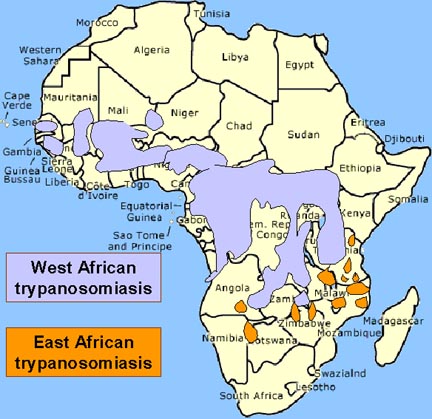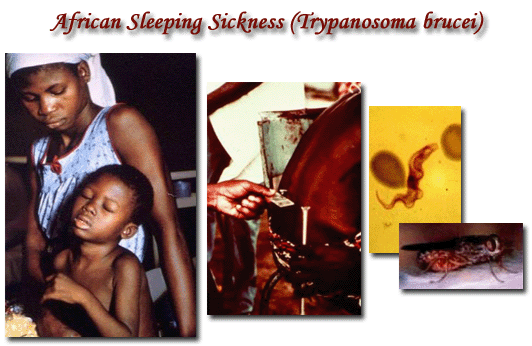This web page was produced as an assignment for an undergraduate course at Davidson College.
FUTURE PROJECTS

Though current treatments are either toxic, uneffective or too expensive, the World Health Administration has come up with a preliminary strategy designed to more agressively combat the Trypanosoma brucei issue. They want to do more than just treat the current victims, they intend to attempt to decrease its prevalence entirely.
They recommend:
- Mobile medical surveillance of the population at risk by specialized staff using the most effective diagnostic tools (serology and parasitology) available. They intend to keep better records and improve patient care by refering victims to specific centres for determination of the stage of the disease and treatment, and for post-therapeutic follow-up
- Fixed post medical surveillance delivered at dispensaries, health centres or hospitals where blood samples are taken and analyzed at reference centres. All patients or suspected cases are sent to special centres for confirmation of diagnosis, determination of the stage of the disease and treatment, and for post-therapeutic follow-up
- Vector (Glossina ) control using screens and traps: simple, cheap and ecologically acceptable methods.
Though these steps for monitoring the infected seem hopelessly futile, the continued research for an effective drug gives hope to victims of African Sleeping Sickness. Since Trypanosoma brucei escapes detection by the victim's immune system via constant genetic alteration of its protien coat, any drug that could cause a break down of this coat would have a good shot at destroying the organism. Currently scientists have found and are working to develop two possibilities.
- The coat of Trypanosoma brucei contains very low amounts of cytidine triphosphate, a molecule essential for cell survival, and researchers at Umea University have demonstrated that a protein called cytidine triphosphate synthetase, which helps synthesize CTP, can be inhibited using inhibited by acivicin, an anti-cancer drug that was tested in humans and animals but has now been abandoned. The researchers tested the action of the drug on mice infected with the trypanosome parasite and found the infection was suppressed for at least one month without serious side effects.
- A new study also suggest that the parasite contains algae genes, and thus could succumb to drugs based on herbicides. Researchers recently analyzed the genomes of two types of trypanosomatids and found that Trypanosoma brucei contains 16 genes closely related to genes found in plants. The corresponding plant genes contribute to photosynthesis. Trypanosomatids lack the ability to photosynthesis but the scientists did detect proteins produced by these genes in the microbes' glycosomes, which help them extract energy from food. These scientisist propose that a small algal organism used to live inside trypanosomatids, and was eliminated by evolution save for some of its genes. They believe that the findings could point to new ways to combat parasitic diseases since the effects of a variety of agricultural herbicides on trypanosomes can easily be tested.
-


